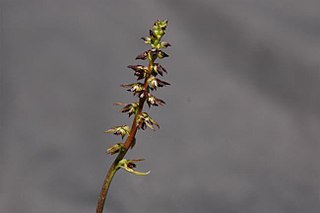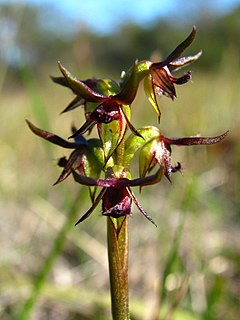
Genoplesium plumosum, commonly known as the Tallong midge-orchid or plumed midge-orchid, is a species of orchid endemic to New South Wales. It is a small orchid only known from a few sites near the towns of Tallong and Wingello on the Southern Tablelands and is only relatively easy to find for about a month, when it flowers. It has been classified as "Endangered" under the EPBC Act.

Genoplesium nigricans, commonly known as mallee midge orchid, is a species of orchid endemic to Australia. It is a terrestrial herb with a single leaf mostly surrounding the stem, and up to 50 tiny, greenish flowers with a deep maroon-coloured labellum and often have a fruity fragrance. Australian authorities use the name Corunastylis tepperi, a widespread species which has been confused with Corunastylis nigricans, a species with purplish brown flowers and which only occurs on Kangaroo Island and the Eyre Peninsula.
Genoplesium rufum, commonly known as the rufous midge-orchid, is a species of orchid endemic to New South Wales. It has a single thin, wiry leaf and up to twenty five drooping, pinkish or reddish flowers on a flowering stem which is fused to the lower part of the leaf. It was formerly thought to range from Queensland to South Australia and Tasmania but specimens in other states are now assigned to Genoplesium clivicola.

Genoplesium filiforme, commonly known as the glandular midge orchid is a small terrestrial orchid endemic to the east coast of Australia. It has a single thin leaf and up to thirty greenish to purple flowers with a reddish-purple labellum. The edges of its flower parts are covered with many short glandular hairs. It is found from southern Queensland to southern New South Wales.

Genoplesium morrisii, commonly known as the bearded midge orchid and known as Corunastylis morrisii in Australia, is a small terrestrial orchid endemic to south-eastern Australia. It has a single thin leaf fused to the flowering stem and up to fifteen small, dark purplish-black or green and purple flowers.
Genoplesium acuminatum, commonly known as the pointed midge orchid and as Corunastylis acuminata in Australia, is a small terrestrial orchid endemic to eastern Australia. It has a single thin leaf fused to the flowering stem and up to sixteen small, hairy, greenish purple to brownish purple flowers. It is found in coastal and near-coastal parts of New South Wales and Queensland.

Genoplesium archeri, commonly known as the elfin midge orchid and as Corunastylis archeri in Australia, is a small terrestrial orchid endemic to south-eastern Australia. It has a single thin leaf fused to the flowering stem and up to fifteen small, hairy, yellowish green flowers with purple stripes. It grows in a wide range of habitats in New South Wales, Victoria and Tasmania.
Genoplesium brachystachyum, commonly known as the Rocky Cape midge orchid or short-spike midge orchid, is a species of small terrestrial orchid endemic to Tasmania. It has a single thin leaf fused to the flowering stem and up to twelve small, green to brownish green, and reddish flowers. It usually grows in heath in rocky places near the coast.

Corunastylis ciliata, commonly known as the fringed midge orchid, is a small terrestrial orchid endemic to southern Australia. It has a single thin leaf fused to the flowering stem and up to fifteen small, green to greenish yellow flowers with purplish markings and a reddish purple labellum. It was formerly included with Corunastylis archeri, and C. ciliata is regarded as a synonym of Genoplesium archeri by the World Checklist of Selected Plant Families. Plants in this species have fewer, more erect flowers, a less-hairy labellum and have different coloration than C. archeri.
Genoplesium eriochilum, commonly known as the Mount Wilson midge orchid, is a species of small terrestrial orchid endemic to the Blue Mountains. It has a single thin leaf fused to the flowering stem and up to twenty small, crowded, dark purplish brown flowers. It usually grows between low shrubs and sedges.
Genoplesium firthii, commonly known as Firth's midge orchid, is a species of small terrestrial orchid endemic to Tasmania. It has a single thin leaf fused to the flowering stem and up to six small, yellowish green or reddish flowers with a red labellum. It grows in coastal heath and scrub and is currently known only from a single population of about twelve plants near Coles Bay.
Genoplesium oliganthum, commonly known as the Mongarlowe midge orchid is a species of small terrestrial orchid which is endemic to New South Wales. It has a single thin leaf and up to nine greenish brown to reddish flowers with a purplish labellum. It grows with grasses and shrubs on the Southern Tablelands.
Genoplesium pedersonii, commonly known as Pederson's midge orchid, is a species of small terrestrial orchid endemic to the Blackdown Tableland in Queensland. It has a single thin leaf fused to the flowering stem and up to thirty small, greenish red to reddish, self-pollinating flowers with a dark purplish red labellum. The species is treated as Corunastylis pedersonii in Queensland.

Genoplesium ruppii, commonly known as Rupp's midge orchid, is a species of small terrestrial orchid that is endemic to eastern Australia. It has a single thin leaf fused to the flowering stem and up to twenty five small, hairy green flowers with a purple labellum.
Genoplesium sagittiferum, commonly known as the horned midge orchid, is a species of small terrestrial orchid that is endemic to New South Wales. It has a single thin leaf fused to the flowering stem and up to ten small, yellowish-green flowers with a hairy reddish labellum.
Genoplesium simulans, commonly known as the Blue Mountains midge orchid is a small terrestrial orchid which is endemic to New South Wales, where it mainly occurs in the Blue Mountains. It has a single thin leaf and up to twenty three dark purplish-black flowers which lean downwards.
Genoplesium tasmanicum, commonly known as the Tasmanian midge orchid, is a species of small terrestrial orchid that is endemic to Tasmania. It has a single thin leaf and up to twenty five dark purplish-black and green flowers. It is widespread and common at lower altitudes.
Genoplesium validum, commonly known as the Blackdown midge orchid, is a species of small terrestrial orchid that is endemic to the Blackdown Tableland National Park in Queensland. It has a single thin leaf fused to the flowering stem and up to thirty five greenish-brown flowers with reddish stripes and a hairy labellum. This species is treated as Corunastylis valida in Queensland.
Corunastylis densa, commonly known as the dense midge orchid, is a small terrestrial orchid endemic to eastern Australia. It has a single thin leaf fused to the flowering stem and up to twenty five densely crowded reddish-brown to dark purplish-brown flowers. It is found between the New England National Park and the Moroka River.
Corunastylis trifida, commonly known as the blackish midge orchid, is a small terrestrial orchid endemic to New South Wales. It has a single thin leaf fused to the flowering stem and up to twenty five dark purplish-black and green flowers. It grows in heath in scattered places in the Sydney basin.






